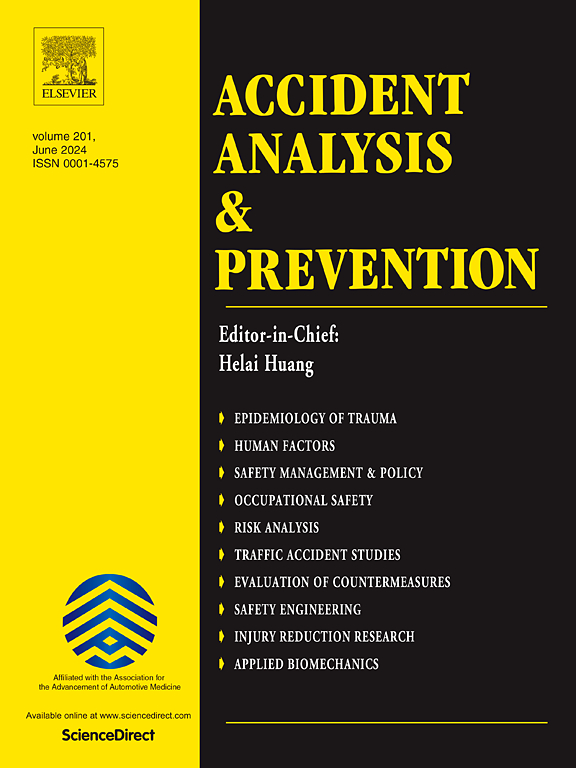宾西法尼亚州两车道乡村公路通行区路段的安全性能:基于因果推理和未观察异质性模型的碰撞修正因素比较
IF 6.2
1区 工程技术
Q1 ERGONOMICS
引用次数: 0
摘要
双车道农村公路上的通行区是根据与路段第85百分位速度或张贴速度限制相关的最小通行视距标准进行标记的。尽管与通行相关的撞车事故在农村双车道高速公路上报告的撞车事故总数中所占比例相对较小,但过去的研究表明,与非通行相关的撞车事故相比,通行相关的撞车事故往往造成更严重的伤害。然而,有通行区路段的安全性能还没有被量化,也没有与没有通行区路段进行比较。本文的目的是使用宾夕法尼亚州的数据来比较有和没有通行区标记的双车道农村公路的安全性能。总碰撞、致命加伤害碰撞和目标碰撞被用来估计碰撞修正因子(CMFs)的存在的传球区。本文的第二个目标是比较使用两种不同方法学方法开发的CMFs:倾向得分-潜在结果因果推理框架和未观察到的异质性(随机参数)模型。结果表明,使用这两种方法开发的cmf是相似的,尽管从未观察到的异质性模型中得出的cmf往往比因果推理方法估计的通过区域段的预期碰撞略少。根据因果推理方法,与没有通行区的路段相比,有通行区的路段发生的总碰撞、致命和伤害碰撞以及正面和侧面碰撞分别减少了11.2%、12.2%和10.6%。本文章由计算机程序翻译,如有差异,请以英文原文为准。
Safety performance of passing zone segments on two-lane rural highways in Pennsylvania: Comparing crash modification factors from causal inference and unobserved heterogeneity models
Passing zones on two-lane rural highways are marked based on minimum passing sight distance criteria associated with the 85th-percentile speed or posted speed limit along the roadway segment. Although passing-related crashes account for a relatively small proportion of total reported crashes on two-lane rural highways, past research suggests that they tend to result in more severe injuries than non-passing-related crashes. However, the safety performance of roadway segments with passing zones has not been quantified or compared to segments with no passing zones. The purpose of this paper is to use data from Pennsylvania to compare the safety performance of two-lane rural highways with and without the presence of passing zone markings. Total crashes, fatal plus injury crashes, and target crashes are used to estimate crash modification factors (CMFs) for the presence of passing zones. A second objective of the paper is to compare the CMFs developed using two different methodological approaches: the propensity scores-potential outcomes causal inference framework and unobserved heterogeneity (random parameters) models. The results indicate that the CMFs developed using these two approaches are similar, although the CMFs from the unobserved heterogeneity models tended to estimate slightly fewer expected crashes in passing zone segments than the causal inference method. When compared to road segments without passing zones, those with passing zones experienced fewer total crashes, fatal and injury crashes, and head-on plus sideswipe crashes by 11.2 %, 12.2 %, and 10.6 %, respectively, based on the causal inference method.
求助全文
通过发布文献求助,成功后即可免费获取论文全文。
去求助
来源期刊

Accident; analysis and prevention
Multiple-
CiteScore
11.90
自引率
16.90%
发文量
264
审稿时长
48 days
期刊介绍:
Accident Analysis & Prevention provides wide coverage of the general areas relating to accidental injury and damage, including the pre-injury and immediate post-injury phases. Published papers deal with medical, legal, economic, educational, behavioral, theoretical or empirical aspects of transportation accidents, as well as with accidents at other sites. Selected topics within the scope of the Journal may include: studies of human, environmental and vehicular factors influencing the occurrence, type and severity of accidents and injury; the design, implementation and evaluation of countermeasures; biomechanics of impact and human tolerance limits to injury; modelling and statistical analysis of accident data; policy, planning and decision-making in safety.
 求助内容:
求助内容: 应助结果提醒方式:
应助结果提醒方式:


